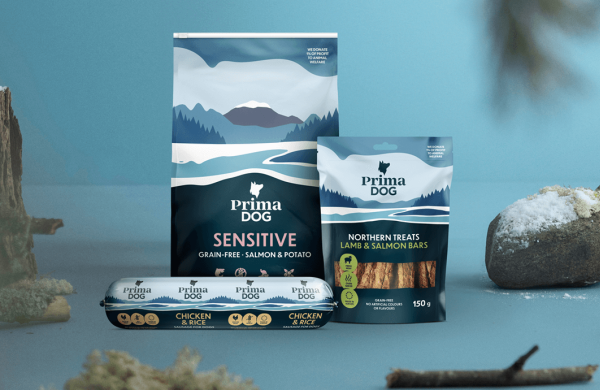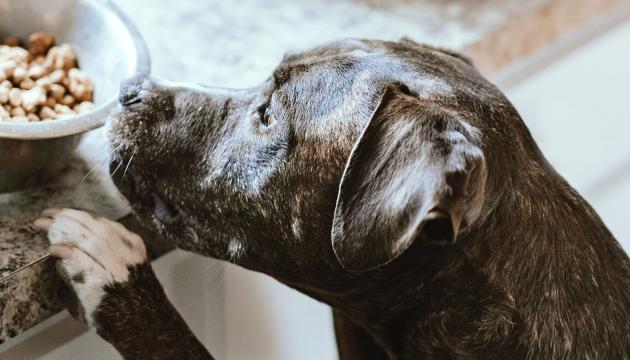

Choosing the best dog food: What should you consider?
The best dog food is the one that suits your furry friend's tummy, entices the dog to eat, and keeps it healthy and happy. However, finding the best dog food can feel like a daunting task with so many options available. But no worries, we are here to help make the process a breeze! In this article, we will share our best tips on how to choose the best dog food for your own tail-wagger.
How do I know if the food is suitable for my dog?
Every dog is unique, just like their food preferences. While you don't need to be Sherlock Holmes with a magnifying glass, it is good to be aware of your dog’s habits and reactions to different foods. Understanding how your dog's stomach functions and how its body responds to new foods can simplify the decision-making process. So, keep an eye on the dog’s digestion, coat condition, and overall well-being to ensure everything is thriving. Read more about changing the dog’s diet.
A meaty complete dog food is often the simplest option to go. Most dry dog foods are complete foods, which means they contain all the nutrients the dog needs on a daily basis. While for wet dog food, check the packaging to be sure if the food is a complete or complementary food. A good dog food should have all the essential nutrients to keep your dog in excellent shape.
Easy steps to evaluate if the food is right for your dog:
- Skin and coat: The dog’s skin is not itching, and the dog doesn’t have constant yeast infections on paws or in the ears. A proper diet helps to keep your dog’s coat shiny and smooth.
- Weight: The dog maintains normal body weight and has good general health.
- Healthy stomach and good digestion: The dog’s digestion system should work regularly. Also, your dog’s poop tells a lot about the dog’s gut health. The dog poop should be solid, soft, moist, and easy to pick up. Check the dog’s diet if the dog suffers often from diarrhea, flatulence, acid reflux, constipation or nausea.
What is the best dog food for my dog?
The best dog food for your four-legged companion depends on their specific needs. Factors like age, size, activity level, and any existing health conditions play a role in determining the ideal food. For instance, a young dog who zooms around here and there requires a diet rich in energy. An older dog who strolls peacefully in the yard might benefit from a food with slightly lower fat content to avoid putting excess strain on its aging joints.
Practical tips for choosing the best dog food
When considering the best dog food for your furry friend, start by answering these questions:
- How old is your dog? Dogs have different dietary needs throughout their life stages. Make sure to adjust your dog’s diet based on factors such as growth and waistline. Feed a puppy with dog food specifically formulated to support its growth. Check out our guide on feeding puppies for more information. Old dogs, on the other hand, may benefit from food containing joint supplements or lower fat content if they are less active.
- Is your dog big or small? The size of your dog primarily affects the portion size. However, larger dogs can also benefit from food containing joint supplements. Food designed for small dogs usually has kibble size suitable for their smaller mouths and slightly higher energy content, as small dogs tend to burn more energy proportionally compared to larger ones.
- How active is your dog? Check our guide on assessing your dog's activity level and how it impacts the dog’s feeding.
- Does your dog need to lose weight? If your furry companion has gained some extra pounds, look for lower-fat food option or incorporate wet food alongside the kibble. Wet food contains water, so it fills up the dog's tummy with fewer calories.
- Does your dog need to gain weight? Putting weight on a dog can sometimes be trickier than helping them lose weight. At first consult with a veterinarian to determine the underlying cause of weight loss. If there are no health issues, choose a dog food rich in protein and fat. For instance, you can try PrimaDog Active Duck & Herring dry food. If your dog's current food is already suitable, it may not be necessary to switch. Instead, you can add meats containing around 15–20% fat to the dog’s diet. Remember to make changes to your dog's food gradually.
- Does your dog have allergies or food sensitivities? Not all sources of animal-based protein are suitable for every dog. For dogs with sensitive stomachs, try protein sources such as venison, fish, or turkey, which are generally well-tolerated. Consult with a veterinarian for specialized diets in case of medical conditions.
What kind of food does your dog enjoy? The best dog food also tastes good! If your dog often leaves its kibble untouched, try variating the diet with wet dog food or adding meat. Let's make mealtime exciting for them; read PrimaDog's tips on adding variety to your dog's diet.
Don't forget the details
Once you have selected a dog food from the store shelf, take a quick look at the fine print on the packaging.
- Check the main ingredient: Look for foods with meat or fish listed as the first ingredient. This ensures a higher meat content, which is essential for your dog's well-being since meaty food forms the base for a dog’s diet.
- Consider the carbohydrates: If your dog is prone to skin issues, a grain-free dog food might be a good option.
All PrimaDog dog foods are wheat-free, and our range includes both grain-free dry and wet foods. The main ingredient in our dog foods is always either meat or fish. Explore PrimaDog products and give your furry friend a taste of Nordic happiness.





